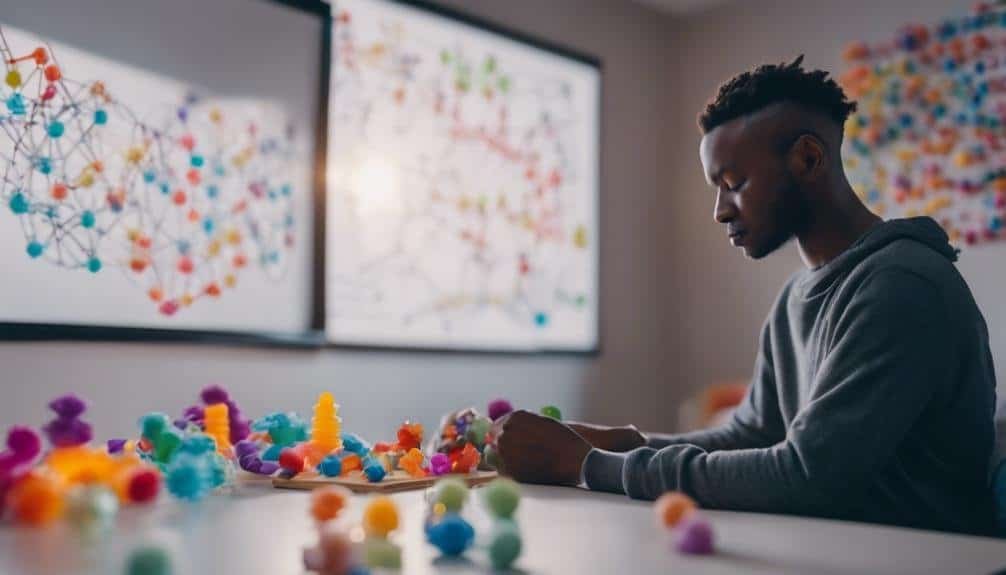Therapy Techniques for ADHD
You might have heard about the various therapy techniques available for managing ADHD, but do you know which ones could be most effective for you or a loved one?
From Cognitive-Behavioral Therapy to Neurofeedback Techniques, the options can seem overwhelming. However, understanding how each technique works and the potential benefits they offer can help you navigate the path towards finding the right approach for addressing ADHD symptoms.
Key Takeaways
- Cognitive-Behavioral Approaches offer practical strategies for managing ADHD symptoms.
- Mindfulness Practices enhance focus, awareness, and emotional regulation in individuals with ADHD.
- Parental Support and Training teach positive reinforcement and behavior modification techniques.
- Behavioral Interventions focus on teaching new behaviors and improving self-regulation in children with ADHD.
Cognitive-Behavioral Therapy
When addressing ADHD, cognitive-behavioral therapy offers practical strategies to manage symptoms effectively. Coping strategies play an important role in helping individuals with ADHD navigate daily challenges. Through cognitive-behavioral therapy, you can learn specific coping mechanisms tailored to your needs. These strategies focus on identifying triggers that exacerbate your symptoms and developing personalized plans to address them. By understanding how your thoughts and behaviors impact your ADHD, you can proactively manage impulsivity, inattention, and hyperactivity.
Stress management is another key component of cognitive-behavioral therapy for ADHD. Learning how to recognize stressors and implementing effective stress-reduction techniques can improve your symptom management. Techniques such as deep breathing exercises, mindfulness, and time-management skills can help you better cope with stress and prevent it from escalating into overwhelming situations. By incorporating stress management strategies into your daily routine, you can enhance your overall well-being and reduce the negative impact of ADHD symptoms on your daily life.
Mindfulness Practices
When dealing with ADHD, practicing mindfulness can bring about numerous benefits. By integrating mindfulness practices into your routine, you can cultivate greater focus and awareness.
Let's explore the advantages and practical tips for incorporating mindfulness techniques to help manage ADHD symptoms.
Benefits of Mindfulness
Engaging in mindfulness practices can greatly benefit individuals with ADHD by helping them cultivate greater self-awareness and emotional regulation skills. Mindfulness benefits include focus enhancement, which is vital for those with ADHD who often struggle with maintaining attention.
By practicing mindfulness techniques, such as focused breathing or body scans, individuals can experience improvements in attention span and concentration. These techniques encourage redirecting attention back to the present moment, reducing distractions that commonly derail focus.
Additionally, mindfulness can aid in recognizing and managing overwhelming emotions that frequently accompany ADHD. Through consistent practice, individuals can develop the ability to observe their thoughts and feelings without immediate reaction, fostering a sense of inner calm and increased self-control.
Practice Tips for ADHD
To enhance your ADHD management, incorporating mindfulness practices into your daily routine can provide valuable support and assistance in improving focus and emotional regulation skills. Mindfulness techniques can be beneficial for time management, helping you stay on track and prioritize tasks effectively.
By practicing mindfulness, you can enhance your self-care routine, promoting overall well-being and reducing stress levels. Taking moments throughout your day to engage in mindfulness practices such as deep breathing, body scans, or mindful walking can help you center yourself, increase awareness of your thoughts and emotions, and improve your ability to stay present.
These practices can empower you to navigate challenges with greater ease and cultivate a sense of calm amidst the daily demands of life.
Parent Training
Parent Training is an essential component in effectively managing ADHD symptoms in children. By learning techniques such as positive reinforcement and behavior modification, parents can create a structured and supportive environment that aids in managing their child's ADHD. Effective communication and boundary setting are key aspects of parent training that can help improve behavior and reduce impulsivity in children with ADHD.
Through parent training programs, caregivers can gain valuable skills to better understand and address their child's needs. These programs provide parents with strategies to promote positive behaviors, set clear expectations, and establish routines that can benefit children with ADHD. By implementing these techniques consistently, parents can create a nurturing and predictable environment that supports their child's development.
Behavioral Interventions
Implementing structured behavioral interventions can greatly improve the management of ADHD symptoms in children. Behavior modification techniques and classroom strategies play a vital role in helping children with ADHD succeed academically and socially. These interventions focus on teaching children new behaviors while discouraging unwanted ones, creating a positive environment for growth and development.
Here is a table highlighting key components of behavioral interventions for ADHD:
| Intervention | Description | Impact |
|---|---|---|
| Behavior Modification | Teaching new behaviors and discouraging unwanted ones | Improved self-regulation |
| Classroom Strategies | Tailoring teaching methods to suit individual needs | Enhancing academic success |
| Parental Support | Providing parents with tools to reinforce positive behaviors | Strengthening family dynamics |
Social Skills Training
When it comes to managing ADHD, social skills training can be a valuable tool for improving communication and problem-solving abilities.
Role-playing exercises can help you practice effective ways to interact with others, while group activities focused on problem-solving can enhance your ability to navigate social situations.
Engaging in peer interaction practice can also foster the development of essential social skills that are essential for building relationships and succeeding in various social settings.
Role-Playing for Communication
Engaging in role-playing exercises can greatly enhance communication skills for individuals with ADHD. Role-playing techniques offer a safe space to practice effective communication strategies in various scenarios. Here are some key benefits of incorporating role-playing for communication:
- Enhances Social Skills: Role-playing allows you to practice social interactions and improve your ability to understand social cues.
- Boosts Confidence: By engaging in role-playing scenarios, you can build confidence in your communication skills.
- Encourages Empathy: Role-playing helps you understand different perspectives and enhances empathy towards others.
- Develops Problem-Solving Skills: Through role-playing, you can practice problem-solving in real-life situations.
- Promotes Active Listening: Role-playing exercises emphasize active listening, a critical aspect of effective communication.
Problem-Solving Group Activities
To further enhance your communication skills and problem-solving abilities, consider participating in problem-solving group activities as part of your social skills training. Engaging in team building challenges and problem-solving games can help you develop essential skills such as collaboration, decision-making, and critical thinking.
Outdoor exercises offer a dynamic setting for group problem-solving, fostering creativity and adaptability in real-time scenarios. By working with others in these activities, you can practice effective communication, active listening, and conflict resolution skills. These group activities provide a supportive environment to learn from different perspectives and brainstorm solutions collectively.
Embrace the opportunity to participate in these engaging exercises to strengthen your social skills and improve your ability to navigate challenges effectively.
Peer Interaction Practice
Consider incorporating peer interaction practice into your social skills training regimen to enhance your ability to connect with others and navigate social situations effectively. Engaging in activities that involve peer support can greatly improve your interpersonal skills and help you feel more confident in social settings.
Here are some key benefits of peer interaction practice:
- Enhances Communication Skills: Practicing with peers can boost your ability to communicate effectively.
- Builds Empathy: Interacting with others allows you to understand different perspectives and develop empathy.
- Encourages Collaboration: Working with peers fosters teamwork and collaboration skills.
- Boosts Confidence: Successfully interacting with peers can increase your self-assurance.
- Provides Real-World Practice: Peer interaction offers practical experience in applying social skills in real-life scenarios.
Executive Functioning Strategies
When dealing with ADHD, incorporating effective executive functioning strategies can greatly improve daily functioning and productivity. Two key strategies that can make a significant difference are time management and task prioritization. It is essential to have tools and techniques that can help you manage your time efficiently and prioritize tasks effectively. Here is a table outlining some executive functioning strategies that can aid individuals with ADHD:
| Strategy | Description | Benefits |
|---|---|---|
| Time Blocking | Allocating specific time blocks for different tasks throughout the day. | Helps in focusing on one task at a time |
| To-Do Lists | Listing down tasks in order of priority and checking them off as they are completed. | Provides a clear overview of tasks |
| Breaks and Rewards | Taking short breaks between tasks and rewarding yourself upon task completion. | Helps in maintaining focus and motivation |
| Setting Reminders | Using alarms or digital reminders to prompt task initiation and completion. | Prevents forgetting important tasks |
Medication Management
Managing medication management for ADHD can be an essential aspect of your treatment plan, offering targeted support for symptom management. When it comes to medication for ADHD, it's vital to contemplate various factors to guarantee effectiveness and minimize potential side effects. Here are some key points to keep in mind:
- Side effects: Be aware of possible side effects that may arise from ADHD medications and discuss any concerns with your healthcare provider.
- Alternatives: Explore alternative treatment options or combinations of therapies if medication alone isn't providing the desired results.
- Dosage adjustments: Work closely with your doctor to determine the appropriate dosage that effectively manages symptoms while minimizing side effects.
- Monitoring: Regularly monitor the effects of the medication on your symptoms and any side effects experienced to make informed decisions about ongoing treatment.
- Consultation: Stay in touch with your healthcare provider to discuss any changes in your condition, concerns, or questions about your medication regimen.
Neurofeedback Techniques
Exploring neurofeedback techniques can offer valuable insights into managing ADHD symptoms through targeted brainwave training. Neurofeedback focuses on brainwave regulation, aiming to improve attention training in individuals with ADHD. By monitoring brainwave patterns through specialized equipment, neurofeedback therapy helps individuals learn to regulate their brain activity more effectively.
During neurofeedback sessions, you'll be guided to engage in tasks that require focus and concentration. Through real-time monitoring of your brainwaves, you'll receive immediate feedback, often in the form of visual or auditory cues, when your brain activity aligns with the desired patterns. This feedback mechanism reinforces the brain's ability to sustain attention and self-regulate, enhancing your overall cognitive function.
As you continue with neurofeedback therapy, you may notice improvements in your ability to concentrate, organize tasks, and manage impulsivity – key areas of difficulty for individuals with ADHD. The targeted brainwave training offered by neurofeedback techniques can empower you to develop essential skills for handling daily challenges associated with ADHD.
Emotional Regulation Techniques
Curious about how you can enhance emotional regulation skills to better manage ADHD symptoms? Developing effective emotional regulation techniques is important for individuals dealing with ADHD. Here are some strategies to help you navigate your emotions and improve your overall well-being:
- Self-soothing techniques: Practice deep breathing, progressive muscle relaxation, or visualization exercises to calm your mind during moments of heightened emotions.
- Mindfulness exercises: Engage in mindfulness meditation or body scans to increase awareness of your thoughts and feelings without judgment.
- Coping mechanisms: Identify healthy coping strategies such as journaling, talking to a trusted individual, or engaging in a favorite hobby to manage stress and overwhelming emotions.
- Stress management: Implement stress-reducing activities like regular physical exercise, adequate sleep, and time management techniques to prevent emotional dysregulation.
- Emotional regulation strategies: Learn to recognize early signs of emotional dysregulation and proactively address them through grounding techniques or seeking professional support when needed.
Environmental Modifications
When managing ADHD, organizing study spaces, reducing distractions, and utilizing visual schedules can greatly enhance focus and productivity.
These environmental modifications are essential in creating a conducive atmosphere for individuals with ADHD to thrive in their daily tasks.
Organized Study Spaces
Creating an organized study space can greatly enhance focus and productivity for individuals with ADHD. To optimize your study environment, consider the following:
- Clutter control: Keep your study area tidy and free of unnecessary items to minimize distractions.
- Focused lighting: Make sure you have adequate lighting that's bright enough to help you stay alert but not too harsh to cause eye strain.
- Ergonomic furniture: Invest in a comfortable chair and desk to promote good posture and reduce physical discomfort.
- Visual aids: Utilize color-coded folders, calendars, or whiteboards to help you stay organized and visually engaged.
- Noise-cancelling headphones: Use headphones to block out distracting sounds and create a more conducive study atmosphere.
Minimize Distractions Effectively
To maintain focus and productivity while studying with ADHD, it's essential to create an environment that minimizes distractions effectively through strategic environmental modifications.
Mindfulness exercises and focus techniques can assist in grounding your attention. Distraction management is vital; consider using noise-canceling headphones or background music to block out disruptive sounds.
Keep your study space tidy and organized to reduce visual clutter that may divert your focus. Utilize natural light or adjustable lighting to create an ideal work environment.
Establish a routine and stick to it, incorporating productivity hacks like the Pomodoro Technique to enhance concentration. By implementing these strategies, you can create a conducive setting that supports your ability to concentrate and learn effectively despite the challenges of ADHD.
Utilize Visual Schedules
Utilizing visual schedules can greatly enhance your organization and time management skills when managing daily tasks and responsibilities. Visual aids play an important role in helping individuals with ADHD stay on track and focused. Here are some key points to take into account:
- Create a visual timeline: Lay out your day or week visually to see tasks at a glance.
- Use color coding: Assign colors to different tasks or activities for better organization.
- Include breaks and rewards: Schedule short breaks and rewards to maintain motivation.
- Place the schedule in a visible location: Make sure your visual schedule is easily accessible and in a prominent spot.
- Update the schedule regularly: Make adjustments as needed to accommodate changes in routine or tasks.
Frequently Asked Questions
Can Therapy Techniques for ADHD Be Effective for Adults as Well as Children?
Yes, therapy techniques for ADHD can be effective for adults and children. Understanding family dynamics is vital. Workplace strategies and coping skills tailored to individual needs enhance effectiveness. Consistent support and guidance are key components for success.
How Can Therapy Techniques for ADHD Be Integrated Into School Settings?
To integrate therapy techniques for ADHD in school settings, consider classroom strategies, involve parents, utilize behavioral interventions, and provide peer support. These elements can create a supportive environment that fosters academic and social success for students.
Are There Specific Therapy Techniques That Are More Effective for Individuals With Combined Type ADHD Versus Predominantly Inattentive or Hyperactive-Impulsive Type?
You might wonder if therapy techniques vary for different ADHD types. Behavior management, cognitive restructuring can help all types. Mindfulness, executive function exercises tailored to specific needs are essential. Each approach aims to enhance focus, control impulsivity.
Can Therapy Techniques for ADHD Be Used in Conjunction With Other Treatment Methods, Such as Dietary Changes or Supplements?
Yes, therapy techniques for ADHD can be used alongside other treatments like dietary changes or supplements. Behavioral interventions, medication, mindfulness, and exercise can complement each other, providing a holistic approach to managing ADHD symptoms effectively.
What Qualifications Should a Therapist Have in Order to Effectively Implement Therapy Techniques for Adhd?
To effectively implement therapy techniques for ADHD, a therapist should possess relevant qualifications such as specialized training in ADHD treatment, experience working with individuals with ADHD, and knowledge of evidence-based therapeutic interventions.
Conclusion
As you navigate the world of ADHD therapy techniques, remember that each method is like a tool in your toolbox. Just like a skilled craftsman, you have the power to choose which tools work best for you or your loved one.
By utilizing these various techniques, you're taking proactive steps towards managing ADHD and improving daily life. Embrace the journey ahead with courage and determination, knowing that each step forward brings you closer to a brighter tomorrow.







